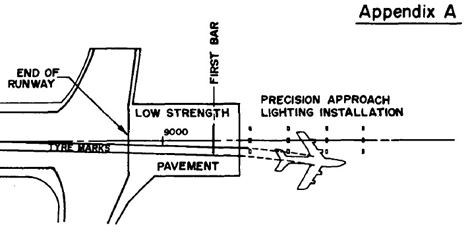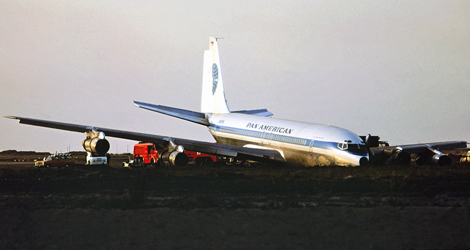Pan American World Airways flight PA812 , a Boeing 707-321B aircraft, registered N892PA, was scheduled to operate a regular public transport flight direct from Sydney, Australia, to Honolulu, U.S.A.
The flight is conducted by Pan American World Airways Inc. under the terms of a Certificate of Public Convenience and Necessity issued by the Civil Aeronautics Board, U.S.A., and an International Airline Licence, Number 207, issued by the Director- General of Civil Aviation, Australia.
There were 125 passengers on board the aircraft.
The scheduled departure time for Flight PA812 was 1745 hours Eastern Standard Time (EST). A flight plan, which was submitted to the Sydney Air Traffic Control Centre at 1609 hours, Indicated that the flight would occupy 8 hours and 57 minutes, and that the aircraft would cruise Initially at flight level 330 and later at flight level 370.
The plan also Indicated that the aircraft had sufficient fuel on board for 10 hours and 29 minutes flight.
Having been provided with the calculated take-off gross weight, the flight crew completed the operational section of the take-off computation card which summarised the take-off conditions and, in addition, showed V speeds and the appropriate power settings for take-off, as follows :
- Take-off EPR : Static 1.83, Rolling 1.85
- Take-off % N1 : 108.8
- Take-off flap setting : 14°
- V1 speed : 138 knots IAS
- VR speed : 145 knots
- IAS V2 speed : 162 knots IAS
- Rated EPR : 1.60
- Rated % N1 : 100.1
While taxiing to the threshold of Runway 34, the crew completed the taxiing check-list and, in communication with Sydney Tower, received and acknowledged an airways clearance. The aircraft was initially instructed to lineup on the runway and hold but, before It had entered the runway, this instruction was changed to a take-off clearance specifying that it would be a radar departure and that, after taking off, the aircraft was to turn right onto a heading of 050 degrees and to maintain 3, 000 feet.

Pan American World Airways – Boeing – B707-321B (N-892PA) flight PA812
This clearance was acknowledged and the pre-take off checks were conducted as the aircraft was turning onto the runway and lining up. These checks included a gyro compass comparison which was conducted as the aircraft heading passed through 010 degrees at which time the aircraft was 34 degrees from runway alignment.
At 1757 hours Clipper 812 commenced Its take-off from a rolling start.
The take-off was being carried out by the First Officer from the right hand seat and, after the First Officer had applied take-off thrust, the Captain took control of the throttles while the Flight Engineer made fine adjustments to the throttle settings to balance the power.
As the aircraft accelerated at an apparently normal rate the Captain called progressively “80 knots your steering”, “one hundred” and “vee one”.
Almost Immediately after the “vee one” call the aircraft struck a flock of seagulls and there were two sharp reports from outside the aircraft. The Captain observed a decay In Number 2 engine EPR and aborted the take-off.
The Captain’s recollection of the sequence of events was that the power loss occurred shortly after the aircraft attained 100 knots and before V1 speed and the recollection was shared by other crew members.
The Captain was scanning the engine Instruments at the time the aircraft struck the birds and loss of power from Number 2 engine occurred. He saw the Number 2 EPR drop from Its setting of 1.85 to about 1.55 and this initiated his decision to abandon the take-off. The Flight Engineer also saw the EPR drop to about 1.55 and called that there was a power loss.
The Captain has stated that he applied considerable braking simultaneously with the selection of speed brake and reverse thrust and full braking almost immediately afterwards. During the early stages of the deceleration, the Flight Engineer saw several flickers of the anti-skid lights on the brake panel, he noted that the hydraulic pressure was normal and saw that the four reverse lights were illuminated and that the N1 values on all engines was about 110% with EPR indications “well up”.
When the Captain took control of the aircraft the First Officer assisted by maintaining the nosewheel on the ground and keeping the wings level and, when reverse thrust was applied, he also placed his feet on the brakes and found that the pedals were fully depressed.
The aircraft over-ran the runway and struck sections of the approach lighting installation which caused the nose landing gear assembly and then the port main landing gear assembly to be removed.
Finally, the nose of the aircraft came to rest partially embedded in soft ground 560 feet beyond the end of the runway and the crew and passengers then evacuated the aircraft.
a number of factors resulted in this aircraft over-running the runway. Firstly, the decision of the pilot to discontinue the take-off being made after the aircraft achieved V1.
- The flight crew were properly qualified for the flight.
- The aircraft was airworthy.
- The aircraft was inadvertently loaded 6,800 Ib in excess of the flight planned weight, primarily as a result of use of a defective hydrometer.
- During the take-off roll, and shortly after V1 speed had been attained, the aircraft struck seagulls and Number 2 engine sustained a compressor stall as a result of bird Ingestion.
- The take-off was abandoned after V1 but the over-run was not inevitable.
- All engines developed full reverse thrust during the deceleration.
- The aircraft and Its systems were capable of normal operation.
- The effective point of commencement of take-off was displaced some 320 feet from the threshold as a result of the rolling start technique employed from a side entry to the runway together with progressive application of thrust.
- The headwind component encountered by the aircraft was significantly less than that forecast and that used In the take-off computations.
- The Increased gross weight of the aircraft resulted In the aircraft travelling 200 feet further than it would have travelled had It been loaded as planned.
- The crew actions In the abandoned take-off procedures were timely in respect of throttle closure, application of reverse thrust and actuation of speed brakes but the evidence Indicates that there may have been a delay in application of wheel brakes beyond that delay assumed in the accelerate/stop certification performance calculations.
- The probable cause of the accident was that, in the circumstances of an abandoned take-off, the aircraft could not be brought to a stop within the nominally adequate runway length because of an error in the calculation of load, a reduction in wind velocity from that forecast and the use of rolling start and braking techniques which would not ensure most effective use of the available runway length.
Download Report


0 Comments